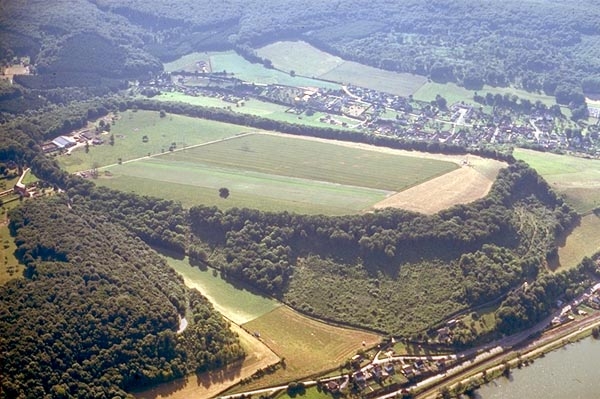- Home
- Discoveries
- Gallic settlements
- Oppida
- Fortified hills
A number of these oppida are located on hilltops, fitting remarkably well into the landscape. The Gauls chose hills that were easily defensible because a good portion of their perimeters were protected by steep natural drops. This is the case at La Chaussée-Tirancourt (Somme), Bracquemont près de Dieppe (Seine-Maritime), Incheville (Seine-Maritime), and Pommiers (Aisne), which are classic examples of what is known as a protected spur, or éperon barré.
These hills are connected to the rest of the plateau solely by a strip of land that the Gauls fortified heavily by digging a ditch — and sometimes two — and by building up a levee of earth that protected this undefended portion naturally (hence the term "protected spur").
These enormous earthworks, easily visible from the ground, have been the subject of attention for quite some time. It is not by chance that these oppida became listed historic monuments early on. In the public's imagination, they could only have been the work of the Romans.
Many of these hills appear in land registries under the name of "Caesar's Camp". Naturally, it was thought that Caesar had hidden treasure in them as well! At Érondelle, the locals still speak of Caesar's "golden chair"!
Several of these oppida are barely discernable from the air, because they are located in the forest, like the one at St Pierre-en-Chastre (Vieux-Moulin, Oise) and at Fécamp (Seine-Maritime).
During World War II, the ditches and levees were considered to be efficient anti-tank obstacles! The places where gun batteries were placed are still visible on the ancient earth levees at La Chaussée-Tirancourt and Liercourt-Erondelle (Somme).
Among the various oppida located on the plains, the two at Variscourt/Condé-sur-Suippe (Aisne) — in the lieux-dits of "Vieux Reims" and "Mur de Rome" — and Villeneuve-Saint-Germain (Aisne) deserve mention. Here, two large parallel ditches protect the meander of the river. The internal structures have been excavated on a wide scale.
The current village of Vermand (Aisne) is located on the oppidum of the Viromandui, which was heavily reinforced in the Late Empire with, among other things, some remarkable funerary bas-reliefs.
The current village of Vermand (Aisne) is located on the oppidum of the Viromandui, which was heavily reinforced in the Late Empire with, among other things, some remarkable funerary bas-reliefs.

